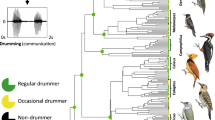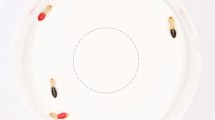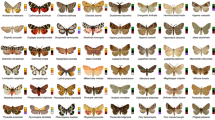Abstract
Aposematism is an anti-predator defence, dependent on a predator’s ability to associate unprofitable prey with a prey-borne signal1. Multimodal signals should vary in efficacy according to the sensory systems of different predators; however, until now, the impact of multiple predator classes on the evolution of these signals had not been investigated2,3. Here, using a community-level molecular phylogeny to generate phylogenetically independent contrasts, we show that warning signals of tiger moths vary according to the seasonal and daily activity patterns of birds and bats—predators with divergent sensory capacities. Many tiger moths advertise chemical defence4,5 using conspicuous colouration and/or ultrasonic clicks3,6. During spring, when birds are active and bats less so, we found that tiger moths did not produce ultrasonic clicks. Throughout both spring and summer, tiger moths most active during the day were visually conspicuous. Those species emerging later in the season produced ultrasonic clicks; those that were most nocturnal were visually cryptic. Our results indicate that selective pressures from multiple predator classes have distinct roles in the evolution of multimodal warning displays now effective against a single predator class. We also suggest that the evolution of acoustic warning signals may lack the theoretical difficulties associated with the origination of conspicuous colouration.
This is a preview of subscription content, access via your institution
Access options
Subscribe to this journal
Receive 51 print issues and online access
$199.00 per year
only $3.90 per issue
Buy this article
- Purchase on Springer Link
- Instant access to full article PDF
Prices may be subject to local taxes which are calculated during checkout




Similar content being viewed by others
References
Cott, H. B. Adaptive Coloration in Animals (Methuen, London, 1940)
Mappes, J., Marples, N. & Endler, J. A. The complex business of survival by aposematism. Trends Ecol. Evol. 20, 598–603 (2005)
Ruxton, G. D., Sherrat, T. N. & Speed, M. Avoiding Attack: the Evolutionary Ecology of Crypsis, Warning Signals and Mimicry (Oxford Univ. Press, Oxford, 2004)
Nishida, R. Sequestration of defensive substances from plants by Lepidoptera. Annu. Rev. Entomol. 47, 57–92 (2002)
Hristov, N. & Conner, W. E. Effectiveness of tiger moth (Lepidoptera, Arctiidae) chemical defenses against an insectivorous bat (Eptesicus fuscus). Chemoecology 15, 105–113 (2005)
Hristov, I. H. & Conner, W. E. Sound strategy: acoustic aposematism in the bat–tiger moth arms race. Naturwissenschaften 92, 164–169 (2005)
Cadman, M. D., Eagles, P. F. J. & Helleiner, F. M. Atlas of the Breeding Birds of Ontario (Univ. Waterloo Press, Waterloo, 1987)
Godfrey, W. E. 1986. The Birds of Canada, rev. ed. (Natl Mus. Nat. Sci. Canada, Ottawa, 1986)
Ward, P. S., Harmsen, R. & Hebert, P. D. N. An annotated checklist of the Macroheterocera of South-eastern Ontario. J. Res. Lepidoptera 13, 23–42 (1974)
Fullard, J. H. Phenology of sound-producing arctiid moths and the activity of insectivorous bats. Nature 267, 42–43 (1977)
Fullard, J. H. & Barclay, R. M. R. Audition in spring moths as a possible response to differential levels of insectivorous bat predation. Can. J. Zool. 58, 1745–1750 (1980)
Yack, J. E. Seasonal partitioning of atympanate moths in relation to bat activity. Can. J. Zool. 66, 753–755 (1988)
Bennett, A. T. D. & Cuthill, I. C. Ultraviolet vision in birds: what is its function? Vision Res. 34, 1471–1478 (1994)
Lyytinen, A., Lindstrom, L. & Mappes, J. Ultraviolet reflection and predation risk in diurnal and nocturnal Lepidoptera. Behav. Ecol. 15, 982–987 (2004)
Ratcliffe, J. M. & Fullard, J. H. The adaptive function of tiger moth clicks against echolocating bats: an experimental and synthetic approach. J. Exp. Biol. 208, 4689–4698 (2005)
Dooling, R. J., Lohr, B. & Dent, M. L. in Comparative Hearing: Birds and Reptiles (eds Dooling, R. J., Popper, A. N. & Fay, R. R.) 308–359 (Springer, New York, 2000)
Nicolaus, L. K., Cassel, J. F., Carlson, R. B. & Gustavson, C. R. Taste-aversion conditioning of crows to control predation on eggs. Science 220, 212–214 (1983)
Ratcliffe, J. M., Fenton, M. B. & Galef, B. G. An exception to the rule: common vampire bats do not learn taste aversions. Anim. Behav. 65, 385–389 (2003)
Fullard, J. H. & Fenton, M. B. Acoustic and behavioural analyses of the sounds produced by some species of Nearctic Arctiidae (Lepidoptera). Can. J. Zool. 55, 1213–1224 (1977)
Fullard, J. H. & Napoleone, N. Diel flight periodicity and the evolution of auditory defences in the Macrolepidoptera. Anim. Behav. 62, 349–368 (2001)
Purvis, A. & Rambaut, A. Comparative analysis by independent contrasts (CAIC): an Apple Macintosh application for analysing comparative data. Comp. Appl. Biosci. 11, 247–251 (1995)
Maddison, W. P. & Maddison, D. R. Mesquite: a modular system for evolutionary analysis Version 2. 0 <http://mesquiteproject.org> (2007)
Barber, J. R. & Conner, W. E. Acoustic mimicry in a predator–prey interaction. Proc. Natl Acad. Sci. USA 104, 9331–9334 (2007)
Acharya, L. & Fenton, M. B. Echolocation behaviour of vespertilionid bats (Lasiurus cinereus and L. borealis) attacking airborne targets including arctiid moths. Can. J. Zool. 70, 1292–1298 (1992)
Barclay, R. M. R. & Brigham, R. M. Constraints on optimal foraging: a field test of prey discrimination by echolocating insectivorous bats. Anim. Behav. 48, 1013–1021 (1994)
Barber, J. R. & Conner, W. E. Tiger moth responses to a simulated bat attack: timing and duty cycle. J. Exp. Biol. 209, 2637–2650 (2006)
Rowe, C. & Guilford, T. The evolution of multimodal warning displays. Evol. Ecol. 13, 655–671 (1999)
Rowe, C. Sound improves visual discrimination learning in avian predators. Proc. R. Soc. Lond. B 269, 1353–1357 (2002)
Gronquist, M. et al. Attractive and defensive functions of the ultraviolet pigments of a flower (Hypericum calycinum). Proc. Natl Acad. Sci. USA 98, 13745–13750 (2001)
Ronquist, F. & Huelsenbeck, J. P. MrBayes3: Bayesian inference under mixed models. Bioinformatics 19, 1572–1574 (2003)
Stevens, M., Parrage, C. A., Cuthill, I. C., Partridge, J. C. & Troscianko, T. S. Using digital photography to study animal coloration. Biol. J. Linn. Soc. 90, 211–237 (2007)
Simon, C., Frati, F., Beckenbach, A., Liu, H. & Flook, P. Evolution, weighting and phylogenetic utility of mitochondrial gene sequences and a compilation of conserved polymerase chain reaction primers. Ann. Ent. Soc. Am. 87, 651–701 (1994)
Cho, S. et al. A highly conserved nuclear gene for low-level phylogenetics: elongation factor 1-α recovers morphology-based tree for heliothine moths. Mol. Biol. Evol. 12, 650–656 (1995)
Monteiro, A. & Pierce, N. Phylogeny of Bicyclus (Lepidoptera: Nymphalidae) inferred from COI, COII, and EF1-α gene sequences. Mol. Phylogenet. Evol. 18, 264–281 (2001)
Mitchell, A., Mitter, C. & Regier, J. C. Systematics and evolution of the cutworm moths (Lepidoptera: Noctuidae): evidence from two protein-coding nuclear genes. Syst. Ent. 31, 21–46 (2006)
Brower, A. & DeSalle, R. Patterns of mitochondrial versus nuclear DNA sequence divergence among nymphalid butterflies: the utility of wingless as a source of characters for phylogenetic inference. Insect Mol. Biol. 7, 73–82 (1998)
Jacobson, N. L. & Weller, S. J. A cladistic Study of the Arctiidae (Lepidoptera) by Using Characters of Immatures and Adults (Thomas Say Publications in Entomology, Ent. Soc. Am., Lanham, MD, 2002)
Posada, D. & Crandall, K. A. MODELTEST: testing the model of DNA substitution. Bioinformatics 14, 817–818 (1998)
Swofford, D. L. PAUP*: Phylogenetic Analysis using Parsimony (* and other Methods) v. 4.0b 10 (Sinauer Associates, Sunderland, 2003)
Dunn, P. O., Whittingham, L. A. & Pitcher, T. E. Mating systems, sperm competition and the evolution of sexual dimorphism in birds. Evolution 55, 161–175 (2001)
Acknowledgements
We thank R. Hoebeke for access to the Cornell University Insect Collection, T. Eisner for the loan of ultraviolet photography equipment, and the 15 people who scored the photographs. J.M.R. thanks M. Fitzpatrick for discussion. J. Barber, C. Beatty, I. Cuthill, T. Eisner and J. Fullard provided detailed comments that improved the manuscript. This study was funded by research grants to J. Fullard (NSERC), R. Hoy (NIDCD) and J.M.R. (NSERC and DNSRC). Molecular work was conducted at Cornell in the laboratory of R. Harrison and the Evolutionary Genetics Core Facility.
Author Contributions M.L.N. was responsible for genetic analyses. J.M.R. was responsible for behavioural, comparative and signal analyses. J.M.R. wrote the manuscript.
Author information
Authors and Affiliations
Corresponding authors
Rights and permissions
About this article
Cite this article
Ratcliffe, J., Nydam, M. Multimodal warning signals for a multiple predator world. Nature 455, 96–99 (2008). https://doi.org/10.1038/nature07087
Received:
Accepted:
Issue Date:
DOI: https://doi.org/10.1038/nature07087
This article is cited by
-
Predator selection on phenotypic variability of cryptic and aposematic moths
Nature Communications (2024)
-
Southeast Asian clearwing moths buzz like their model bees
Frontiers in Zoology (2021)
-
Deaf moths employ acoustic Müllerian mimicry against bats using wingbeat-powered tymbals
Scientific Reports (2019)
-
Multiple modalities in insect warning displays have additive effects against wild avian predators
Behavioral Ecology and Sociobiology (2019)
-
Distribution of Defensive Metabolites in Nudibranch Molluscs
Journal of Chemical Ecology (2018)
Comments
By submitting a comment you agree to abide by our Terms and Community Guidelines. If you find something abusive or that does not comply with our terms or guidelines please flag it as inappropriate.



